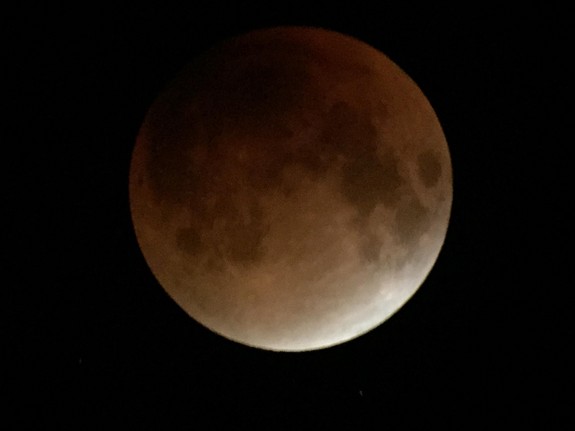10:30 AM | Why the recent lunar eclipse was so dark
Paul Dorian
[Image of the relatively dark moon taken in Massachusetts during totality of the recent eclipse]
Discussion
Overview
On September 27th, the moon passed through the shadow of Earth and the total lunar eclipse was witnessed by millions around the world. Most people agreed that the lunar eclipse was darker than usual (example image above) – not the often seen bright orange or red. Believe it or not, the darker appearance to the moon during the total eclipse was actually due in large part to a volcanic eruption that took place in Chile months earlier.
Volcanic dust in the stratosphere
Chile’s Calbuco volcano erupted in April 2015 and six months later we are still seeing the effects of the volcanic aerosols (ash, dust, sulfuric acid droplets) that reached the lower stratosphere. Sunsets in both hemispheres have been more colorful than normal from the upper atmosphere volcanic aerosols and it appears to have affected the eclipse as well.
When the stratosphere is full of volcanic ash and other aerosols, lunar eclipses then to be dark red whereas when stratospheric conditions are relatively clear, lunar eclipses can be bright orange. Sunlight has to pass through these light-absorbing minerals and chemicals on its way through the atmosphere and into Earth’s shadow. Less light means a darker moon during total eclipse. The eclipse of September 27th was measured by trained observers at 0.4 magnitude dimmer than expected, a brightness reduction of around 33 percent (plot below).
[Predicted lunar eclipse brightness; courtesy Dr. Keen, University of Colorado]
Volcanic dust in the atmosphere also acts to cool the Earth below by reflecting sunlight. This particular volcanic eruption actually created a very small amount of cooling on Earth; however, there have been past eruptions resulting in more significant cooling around the world. For example, the eruption of Pinatubo in 1991 produced much more cooling than Calbuco and it resulted in rare July snows across higher elevations of the US Rocky Mountains.
Other possible contributing factor
Forest fires that raged across the western states and Canadian provinces all spring and summer may also have contributed to the darker than normal appearance of the moon during the recent eclipse. Most of that wildfire smoke usually stays in the lower part of the atmosphere, but some may have found its way to the stratosphere, the very layer responsible for transmitting most of the sunlight that falls into Earth’s shadow and colors the moon.

